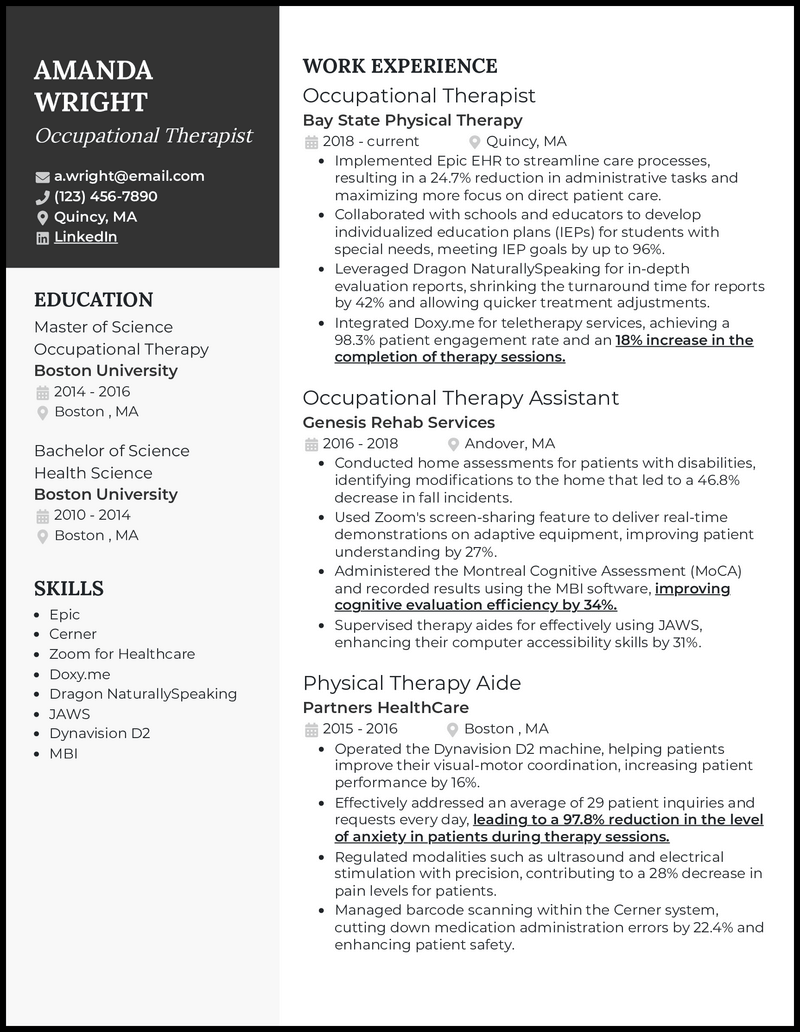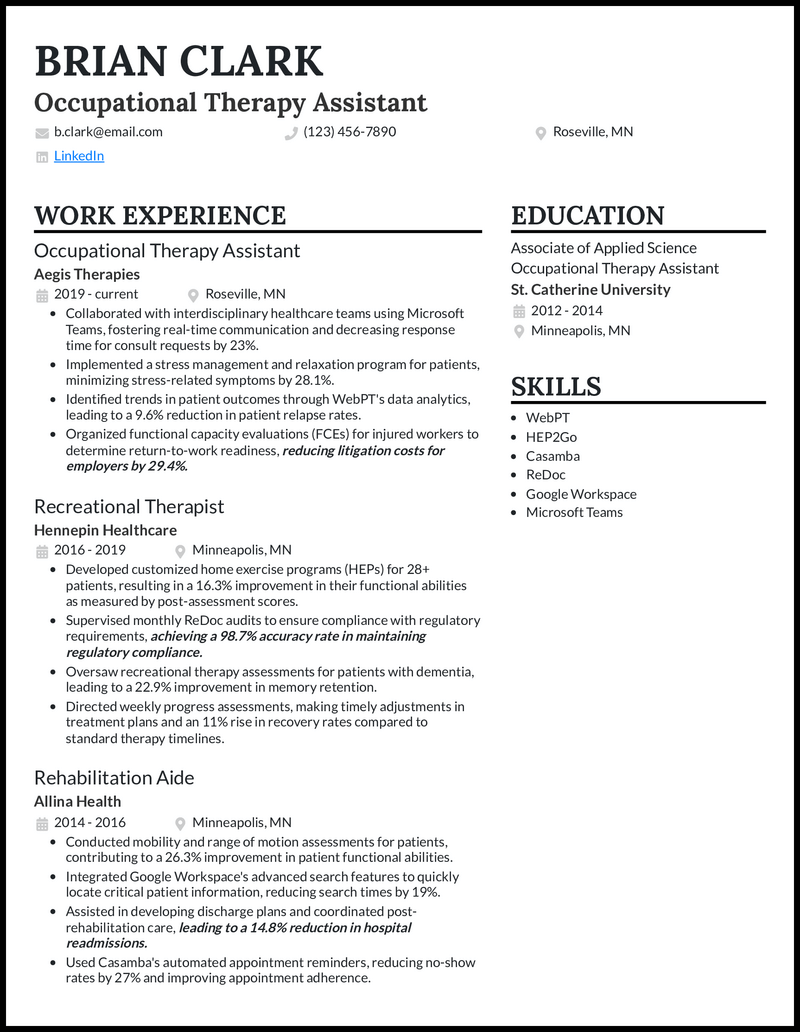Look, snagging this internship isn’t just about your zest for learning—it’s about serving up a platter of your wins, big or small, even if they’re fresh from the university’s halls or your neighborhood volunteering gigs. And what better way to link the skills from past adventures to the qualities that’ll make you a standout than a skillfully crafted occupational therapy intern resume?
- A standardized rundown of skills like Microsoft Office, TherapyEd, LinkedIn Learning, and Time Management is cool. But when you tie those skills or tools to real-world applications—like “Designed personalized plans using TherapyEd”—it suddenly gives your proficiencies life and relevance.
Related resume examples
- Physical therapist
- Chiropractor
- Home health aide
- Personal trainer
- Caregiver
Adjust Your Occupational Therapy Resume to Fit the Job Description

From familiarity with adaptive equipment to speech-language therapy, individual job roles require a wide variety of skills. When you read each job description, tailor the skills section of your resume accordingly. Match their focal points to show how your skill set aligns with the job.
You’ll also want to pay attention to whether the job is more focused on technical, hard skills, or soft skills. If the company you’re applying to is built around patient comfort, don’t exclude interpersonal abilities, even if your primary skills are technical.
Need some ideas to get started?
15 best occupational therapy skills
- Doxy.me
- Patient Advocacy
- Speech-Language
- MedBridge
- TherapyEd
- LinkedIn Learning
- ReDoc
- WebPT
- Patient Assessment
- Casamba
- MS Teams
- Google Workspace
- MBI
- Epic
- Cerner

Your occupational therapy work experience bullet points
While your resume should mirror the job description in terms of what they value the most, make sure you present your compatibility through experiences, not repetition. Think of impactful experiences you’ve had with your patients that you can leverage to demonstrate your effectiveness.
How did you improve overall patient recovery times for your practice? Did you develop a patient development or recovery planning system that made it dramatically easier to log progress?
Just make sure you set off those achievements with metrics so that recruiters can see solid numbers to quantify the difference you’ve made. And always use active verbs and language to demonstrate your enthusiasm for bettering patients’ lives.
- Percentages can indicate improved recovery times
- Reduced work hours show that you can organize and streamline treatment
- Increased patient retention rates demonstrate the longevity of your approach
- Positive feedback ratings speak to your helpful methods and positivity
See what we mean?
- Documented over 286 patient evaluations and progress notes using the Epic system under superior guidance, ensuring an error rate of 0
- Regulated modalities such as ultrasound and electrical stimulation with precision, contributing to a significant decrease in pain levels for patients and earning a personal rating of 4.9/5 stars
- Identified trends in patient outcomes through WebPT’s data analytics, leading to a 9.6% reduction in patient relapse rates
- Integrated Google Workspace’s advanced search features to quickly locate critical patient information, reducing search times by 19% and weekly work hours by 7 on average
- Administered the Montreal Cognitive Assessment (MoCA) and recorded results using the MBI software, improving cognitive evaluation efficiency by 34%
9 active verbs to start your occupational therapy work experience bullet points
- Regulated
- Administered
- Identified
- Communicated
- Advocated
- Documented
- Integrated
- Ensured
- Leveraged
3 Tips for Writing an Occupational Therapy Resume Without Much Experience
- Leverage overlapping experiences
- Not everyone has a background in occupational therapy, but even if your previous jobs were unrelated, they still helped you learn translatable skills. After all, graciously assisting a frustrated customer utilizes empathy and resolution skills that you’ll also use to help struggling patients.
- Try out a career objective
- A resume objective can be ideal for quickly outlining what drives you toward occupational therapy and which of your traits qualify you for it. It’s also the perfect opportunity to connect with a specific company.
- Cite achievements from college
- Don’t underrate the power of academic achievements! If you earned an eye-popping GPA or excelled at any projects or contests related to medicine or helping others, these can boost your credibility.
3 Tips for Writing an Occupational Therapy Resume if You’ve Already Got Some Experience
- Leverage a summary
- As a more experienced professional, you may benefit from using a resume summary to quickly overview some of the shining capabilities and achievements that relate to the specific job role. Just don’t repeat these points later!
- Nix older educational milestones
- If you’ve been using your Bachelors of Occupational Therapy to help reduce stress levels and develop recovery plans already, there’s no need to dig deeper. Only list your highest education on your resume.
- Highlight only the best
- By now, you’ve been working in relevant roles long enough that you can set aside any jobs unrelated to occupational therapy. Pick just three or four jobs that really showcase your best work . . . and then focus on your best experience points!
How long should my resume be?
Stick with a one-page resume! Recruiters need to be able to skim your qualifications quickly, so make sure you streamline that process by keeping your patient success stories concise.
Can I include extra certifications?
By all means! If you’re certified in First Aid, CPR, Special Education, or anything else that will help you assist your patients in overcoming their obstacles, don’t leave them out.
What metrics do I use?
Your metrics should be solid and clearly reinforce your final impact point. If you have a random number like a headcount or monthly appointment lineup, provide quantifiable data that shows how it made a difference.










![]()